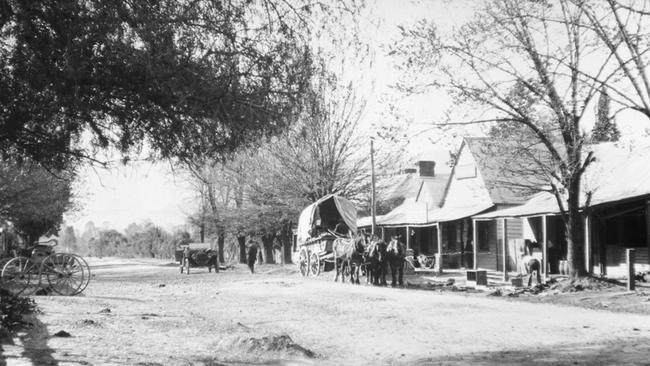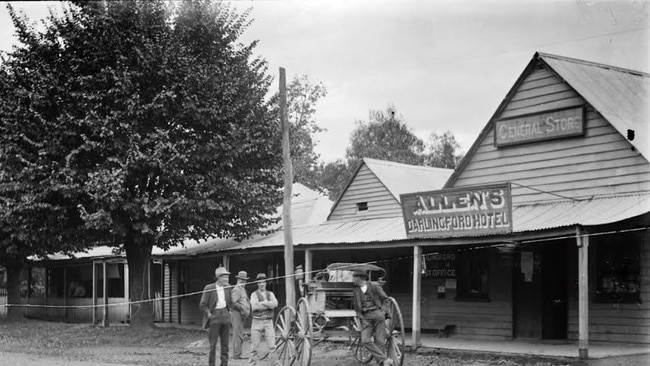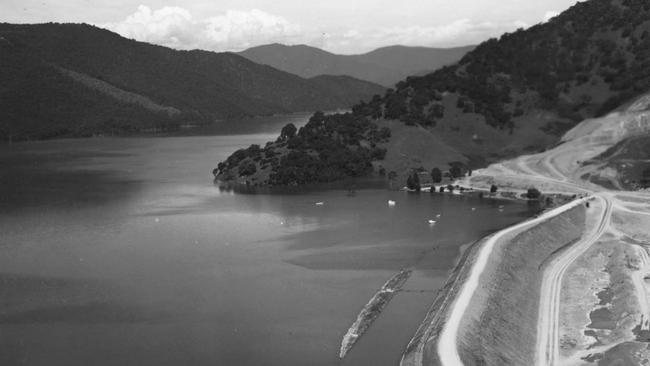How historic Victorian town ended up ‘drowned’ by Lake Eildon
Darlingford was once a bustling gold rush town with pubs, a post office and school. But over a few short years everyone vanished. Now the secrets of Victoria’s drowned town lie beneath Lake Eildon.

VIC News
Don't miss out on the headlines from VIC News. Followed categories will be added to My News.
When gold was struck near Mansfield in the 1860s, a new town sprung up.
The village of Darlingford kept growing, first with a post office, then several hotels and a little school building.
Nestled in the Big River Valley near the junction of Big River and the Goulburn River, the town was bustling in the first decade of the 20th Century.
But in a few short years everyone was gone.
Most of the buildings were dismantled and the entire population moved away.
Soon after that, the water came.
Slowly but steadily it gathered at the foot of the town, then it crept up the walls of the remaining houses, killed the trees and transformed them into gnarled ghosts whose fingers poked above the surface.
Before long Darlingford was completely submerged.
The secrets of Victoria’s drowned town lie beneath the body of water that now rests where the Big River Valley used to be – Lake Eildon.

THE UNDERWATER PUB
The population of Victoria’s northern plains was growing and the State Rivers and Water Supply Commission was figuring out a way to irrigate and droughtproof the uncultivated land.
The valley where Darlingford stood was deemed the perfect basin for a reservoir that could hold 377,000 megalitres of water.
As a consequence the lives of the townspeople were upturned.
One record tells of an effort to exhume the bodies buried in the local cemetery and relocate them to surrounding townships.
Another account tells of an enterprising publican who, knowing the town was doomed, kept the Darlingford Hotel open to serve the workmen building the dam wall that would eventually see the whole town consumed by the river.

Hundreds of workers were contracted by the government to carry out the project and many were housed at what became the town of Eildon.
After knocking off work, some would go down to Darlingford, right in the intended path of the swelling river, for a drink.
Publican Thomas Allen thrived on the extra trade, while it lasted.
The pub finally closed in the early 1920s as the land in the valley was compulsorily claimed by the government, the gates of the new wall were closed and water engulfed the town.
But that wasn’t the end.
Despite expansions in the late 20s and mid 30s, the reservoir’s capacity was too low to service the state’s growing needs.
In 1951 work began on a new dam system that would increase the capacity to a huge 3.3 million megalitres – almost nine times the size of the original weir.
The work was completed in 1955 and more of the valley was flooded.
The dam wall that had caused the flooding of Darlingford was itself completely submerged as a new, bigger reservoir, called Lake Eildon was gradually filled.

DARLINGFORD GHOSTS
The lake became an intergenerational holiday favourite among Victorians.
Immortalised in the Australian film The Castle and a favourite for water skiers and fishers, the huge lake has a shoreline comparable as Port Phillip Bay’s when water levels are high.
The remains of Darlingford are still down there.
Its name is still carried by a few local businesses and institutions including the Darlingford Waters Boat Club close to where the old village lies under the water.
There, a watery town of a different kind has emerged – one made of houseboats.

Rumours swirl around Eildon and Mansfield about the big drought in the early 2000s and the ghosts it uncovered when the water level was critically low.
Some tell of rooftops jutting out of the water and old roads becoming visible on the lake floor.
Others tell of wandering freely around structures that are still, somehow, standing after so many decades under water, finding old carts and pieces of machinery, even shoes left neatly in a row in an abandoned house.
Now a blend of history and folklore, the drowned town of Darlingford may never give up all its secrets.
MORE NEWS
HOW SHONKY EVIDENCE HANGED INNOCENT MAN
